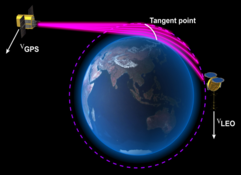Low Earth Orbiting satellites

Low Earth Orbit (LEO) satellites operate at orbital altitudes between 400 and ~3500 km. Among their different scientific objectives, the global sounding of the vertical layers of the neutral atmosphere and the ionosphere is of great importance. These missions carry dual-frequency GPS receivers onboard which makes them capable of remote sensing the atmosphere using the Radio Occultation (RO) technique (Wickert et al., 2001). The RO technique is based on detecting the change in a radio signal passing through the neutral atmosphere and the ionosphere. As a radio signal travels through the atmosphere, it bends depending on the gradient of refractivity normal to the path. Using the RO measurements onboard a LEO satellite the vertical refractivity profile from the LEO satellite orbit height down to the Earth's surface can be computed. Since the index of refractivity depends mainly on the number of free electrons within the ionosphere, the refractivity profile can be inverted to obtain the vertical Electron Density Profile (EDP) (Jakowski et al., 2002).
Some of the LEO satellites mostly used within the chair of satellite geodesy are:
- Formosat-3/Cosmic
- Envisat
- SAC-C
